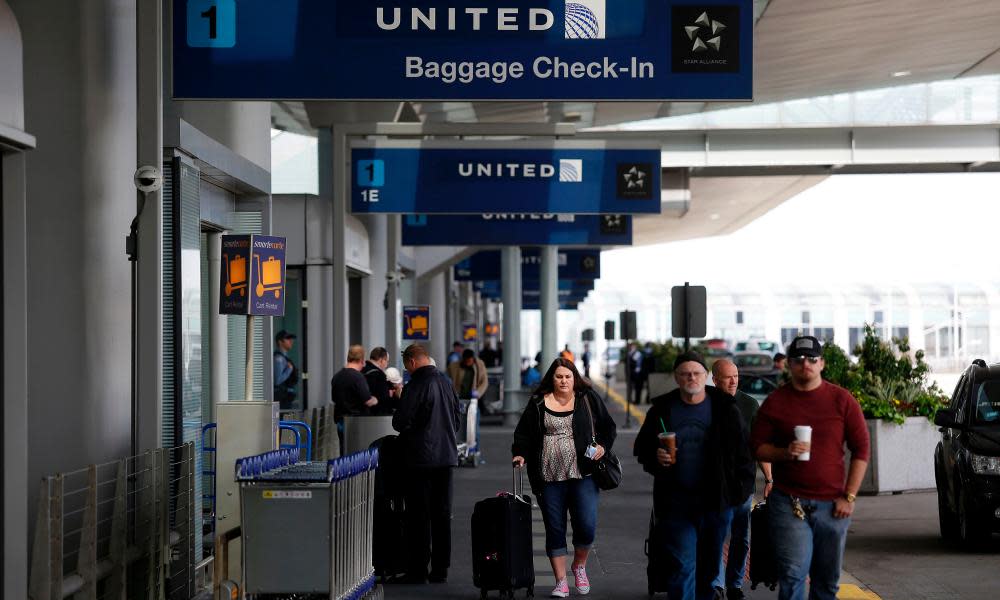More animals died on United Airlines planes in 2016 than any other US carrier

More animals died being transported on United Airlines planes in 2016 than any other US carrier, according to the Department of Transportation.
United, which was heavily criticised after a passenger was dragged off one of its flights earlier in April, faced renewed scrutiny on Wednesday when it emerged that a continental giant rabbit called Simon had died on one of its aircrafts. It has also raised questions about the safety of animal transport on planes.
Animal deaths on flights are still relatively rare. According to DoT statistics, 26 animals died while being transported on planes in 2016, a rate of 0.5 per 10,000 animals transported. A third of those deaths occurred on United Airlines – nine animals (2.11 deaths or injuries per 10,000), and another 14 were injured. While United Airlines had the highest number of animal deaths, one airline, Hawaiian, had a higher incident rate (3.99 per 10,000). But since Hawaiian transports fewer pets than United, the raw number of deaths was three.
A post shared by Mona Chalabi (@mona_chalabi) on Apr 26, 2017 at 2:48pm PDT
These numbers make up a tiny component of animal deaths – in any given year there are 830 cat deaths per 10,000 domesticated cats, and 790 dog deaths per 10,000 domesticated dogs. But animal welfare groups warn that there are risks associated with transporting pets on planes.
The Humane Society of the United States warns pet owners to “be aware of the dangers of flying your pet in a cargo hold.”
“While most animals flown in the cargo area of airplanes are fine, you should be aware that some animals are killed, injured or lost on commercial flights each year,” the Humane Society’s website says. “Excessively hot or cold temperatures, poor ventilation and rough handling are often to blame.”
Simon, who was 3ft long and whose breeder said he could have become the largest rabbit in the world, died on a United flight from London Heathrow to Chicago O’Hare airport. The rabbit, who was brown, had been purchased by someone in the US.
In Simon’s case, the cause of death has yet to be determined. But United issued a statement Thursday saying that Simon was seen moving in his crate 35 minutes after the plane landed and was later found motionless.
“Our customer declined our offer to have an examination conducted to determine a cause of death,” a United spokesperson told the Guardian.“The safety and wellbeing of all the animals that travel with us is of the utmost importance to United Airlines and our PetSafe team,” the spokesperson said.
Ben Williamson, senior international media director at People for the Ethical Treatment of Animals (Peta), said animals should never be transported as cargo.
“Peta urges United to join JetBlue and Southwest in prohibiting companion animals from being flown as checked baggage in the confusion, noise, extreme temperatures and improper pressurization of a cargo hold,” the organization said.
JetBlue explains on its website that it doesn’t allow pets in “cargo” “due to the lack of oxygen and pressurized air”.
Williamson kicked off a list of other ways an animal could die in flight. “Some freeze to death when climate-control systems fail, while others die of heat prostration on the tarmac during lengthy delays, hurt themselves while escaping from carriers, or are injured or killed when heavy items fall during extreme turbulence,” he said.
“The safest way to travel with your animal is to drive, or to take them with you in the passenger cabin if you must fly. Most airlines allow small animals in the cabin as long as their carriers can fit under the seat.”
Eric Stewart, executive director of the American Rabbit Breeders Association and former editor of Domestic Rabbit magazine, said he has flown rabbits on United Airlines and his experience “has been positive”.
“As far as shipping rabbits, it’s very safe,” said Stewart, who has always flown his rabbits in cargo holds. He said it was “fairly common” to fly rabbits in the US, either bringing in breeds from Europe or flying rabbits across the country to attend shows. “It’s shorter time for transport and a lot of time it helps the rabbit settle in more once they arrive,” he said.
Despite this, Stewart said there is the potential for rabbits to injure themselves in transit. “Rabbits are prey animals and they can be sensitive,” he said. Rabbits are often transported in large carriers – sometimes larger than an area they would live in, Stewart said, which can be problematic.
“Given a larger area, if a rabbit becomes spooked it can actually run and spin to the point where they’ll break their own backs or break a leg.”
Rabbits have a very high muscle to skeletal ratio, and very fine bones, Stewart said, meaning sometimes “their own muscles can actually break their own bones”.
“We have thousands of rabbits flying in the air every year in the United States, and incidents are few and far between. In fact, I’m certain that there are more incidents involving rabbits that are being driven somewhere versus going in the air,” Stewart said.

 Yahoo News
Yahoo News 
